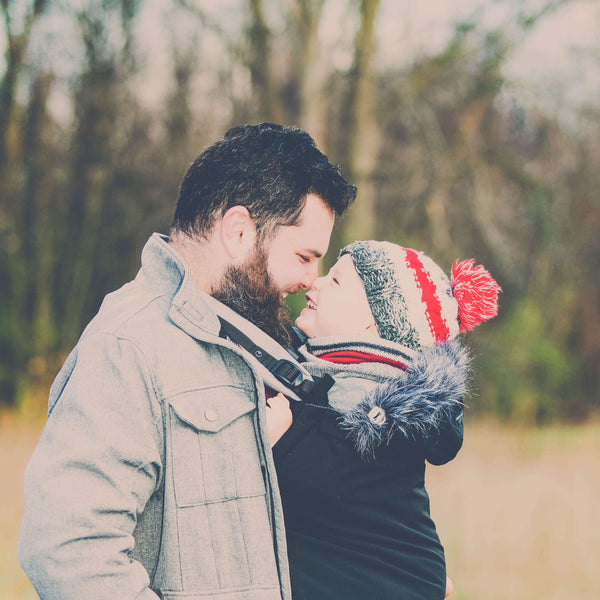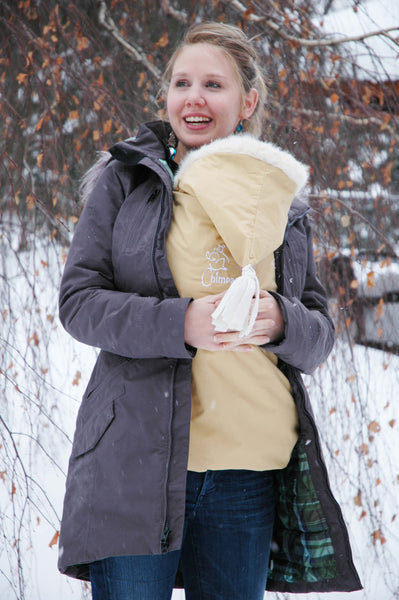
You gave birth in winter and now you're telling yourself that you'll be stuck at home until spring? No way! Having a bowl of fresh air is super important for your mental health as much as your physical health.
Let me give you a few tips to be able to leave the house with your baby this winter and enjoy it worry-free.
At what age do you think you can start going out with your baby? Everyone has an opinion about it, but on average, it's only during the baby's first ten days of his life that a baby is more vulnerable to temperature variations since he's not yet capable of autoregulating his body temperature. Thermoregulation is a mechanism that develops itself and will actually help us enjoy winter with peace of mind! But until it's been properly established in your baby, you'll need to take some precautions.
You've probably heard of skin to skin. It's a technique where the baby is kept in direct contact with your body and to help him with his thermoregulation. It's an excellent thing to do at home, and often, and especially with a premature baby but is also beneficial to babies born full term.
Starting from the same principle, by keeping him as close as possible to your body's warmth, you'll be able to better protect him from the cold. Imagine that you could keep this bubble of heat and properly isolate your baby from the weather, there would then be less danger. It would be as if he were still in your belly, and that bubble could go outside!
Obviously, we need to be reasonable. If it's -30 outside, that a freezing wind is blowing, that you can't stay outside more than a few minutes yourself, maybe you shouldn't choose that day to go out with your baby. This kind of weather isn't good for you and it's not good for your baby either. There's just going to be days where leaving the house with your baby won't be possible.
But on most winter days, with proper clothing, it's not unbearably cold and not too windy and it's even comfortable. You should be mindful of the wind though, as it's bad for your baby: It makes his breathing difficult, speeds up his cooling down, can cause frostbites and is generally uncomfortable for him. You'll always need to protect him from it.

On days where the weather is mild, with a shy winter sun and the temperature is cool, you should absolutely go out to enjoy it. You'll still need to dress for the weather, obviously, and so should be your baby.
How you should dress your baby depends on your physical proximity with him. This will change depending on whether your baby is close to you, in skin to skin, or in his stroller or his car seat. For example, if you're using a baby carrier and you dressed him in a big coat that insulates him from you and that you're also wearing a coat under the baby carrier, no beneficial heat exchange is possible due to the thick barrier of fabrics between you, and this situation changes how you will dress your baby.
There are also times where your baby isn't being active, but you are, and it's not the same body heat management situation. In this case, by being active, us adults feel warm, but a baby, who is inactive, will get cold much faster. It's a situation where you'll need to dress him in warmer clothing than you are. This is where the advice to dress a baby one layer warmer than you comes from. If you feel cold, chances are your baby also feels cold or worse, if you feel cold while being active your baby might be freezing! Be very careful and vigilant. Accidents happen, and that's awful. There are stories of babies who have suffered from hypothermia or frostbites. If you leave the house to do sports, like snowshoeing or hiking, or just going out for a walk, you can feel great while your baby is getting cold in his stroller or even his baby carrier.
I'd say that the solution to this that's the safest and in which I feel the most confident is to carry the baby as close to oneself as possible and to not be separated by as little clothing as possible. Let's go back to the principles of skin to skin. With your baby closer to you, it'll be easier for his body to stay warm thanks to yours. If you walk and feel warm, the warmth you feel due to exertion is shared with your baby, and that's great! On the other hand, if you feel cold and you feel yourself getting colder, the principle applies here, which means your baby is also getting colder, and you'll know that it's time to go back inside.
This sharing of body heat is both reassuring and a good measure of the wellbeing and safety of your baby. By having your baby close to you, you get to truly feel your baby.
You can feel his warmth, you can tell if he feels cold or hot. You're in direct contact with him.
You can carry your baby in any baby carrier, baby wrap or structured carrier. You simply need to get him as close to your body as you can.

Dress as lightly as you can, a tank top or a thin t-shirt is enough. Do the same for your baby, in fact, he could be wearing just his diaper! His body will be covered by yours. What matters the most is that you keep his extremities covered. If your baby is in his baby carrier, his body is kept warm and covered by it, but his legs, arms and head are left exposed, which means you'll have to protect those when going out.
Try to find a beanie or balaclava that'll cover his head and neck. Ideally, you could even get a hat that can cover him down to his shoulders. For his hands, you'll need mittens, but choose a pair that extends into sleeves if you can. Get him leggings or some kind of tubes you can put on either his arms or legs, even over sleeves or pant legs. Next, put thick socks and boots on his feet or a weather-appropriate equivalent.
If your baby's dressed, you're almost ready to leave! It's time to create your insulated bubble of warmth. There's more than one option here. Chimpäroo has the Babygloo cover that's basically a coat for the baby carrier itself that attaches to the carrier. The cover closes on either side of your body to keep you both warm together. It's insulated and resists wind, rain and snow. You then only need to put on your own coat while keeping it fully open or closed only at the bottom. You'll also find on the market coats and sweaters meant for babywearing that are worn over the baby carrier. Whichever you choose, be careful to keep your baby's face free of obstruction and do not close the coat over your baby's head.
The advantage of a Babygloo is that it's easy to take off when you walk in or out of a building. The baby can feel hot rapidly when we're completely dressed up while inside. With a Babygloo cover, there's no need to take off your coat, but only to detach the cover's straps.
Explore the rest of our website chimparoo.ca. You'll be able to read up on our company, our products and our contact details to reach me!
Subscribe to our newsletter and our YouTube channel to know what we're up to!
We're here to help and I'm always happy to answer you questions.
Enjoy your winter!


Share:
6 Babywearing Costumes for Halloween
7 Benefits of Babywearing for a Healthier and More Gentle Life With Baby